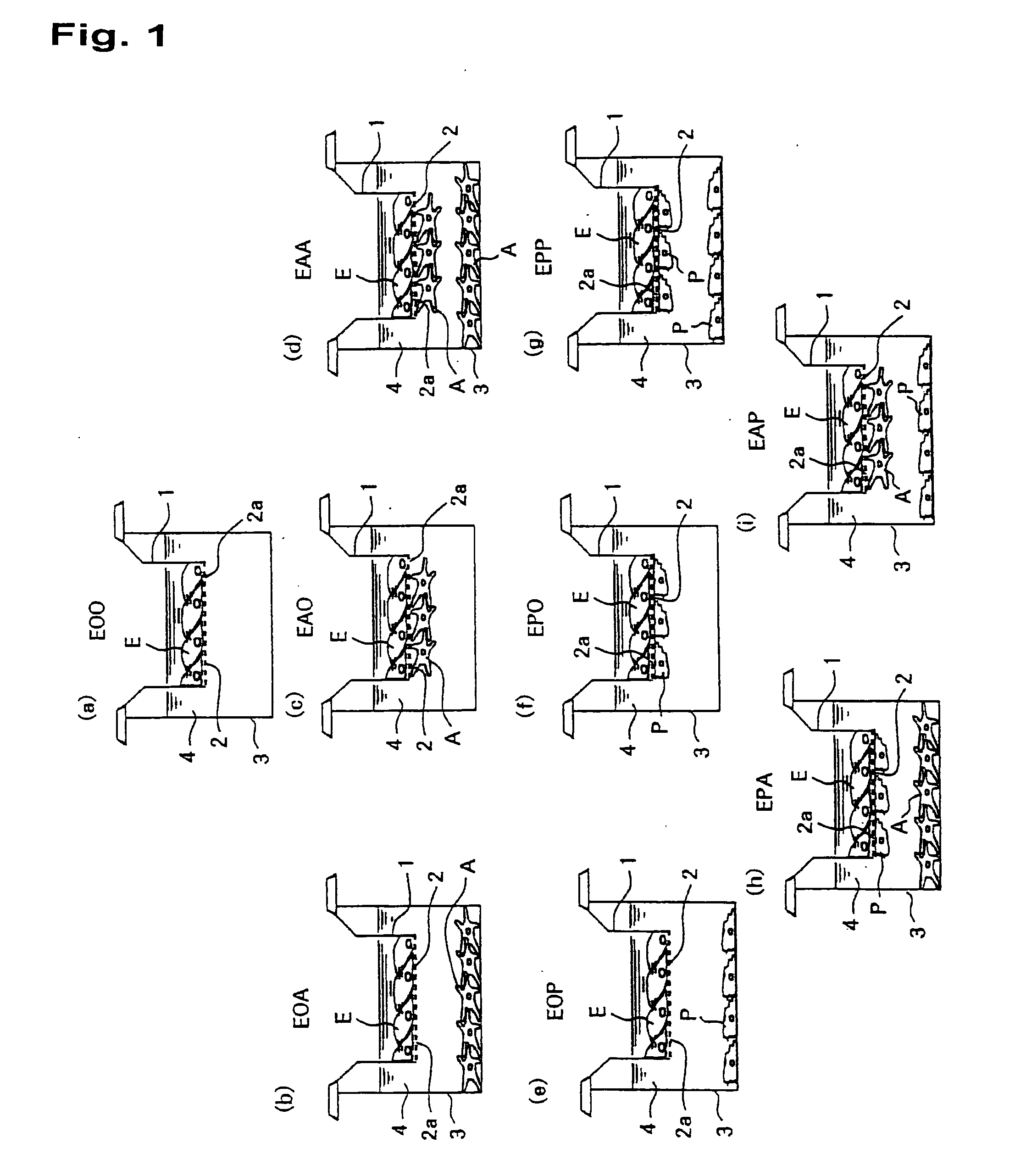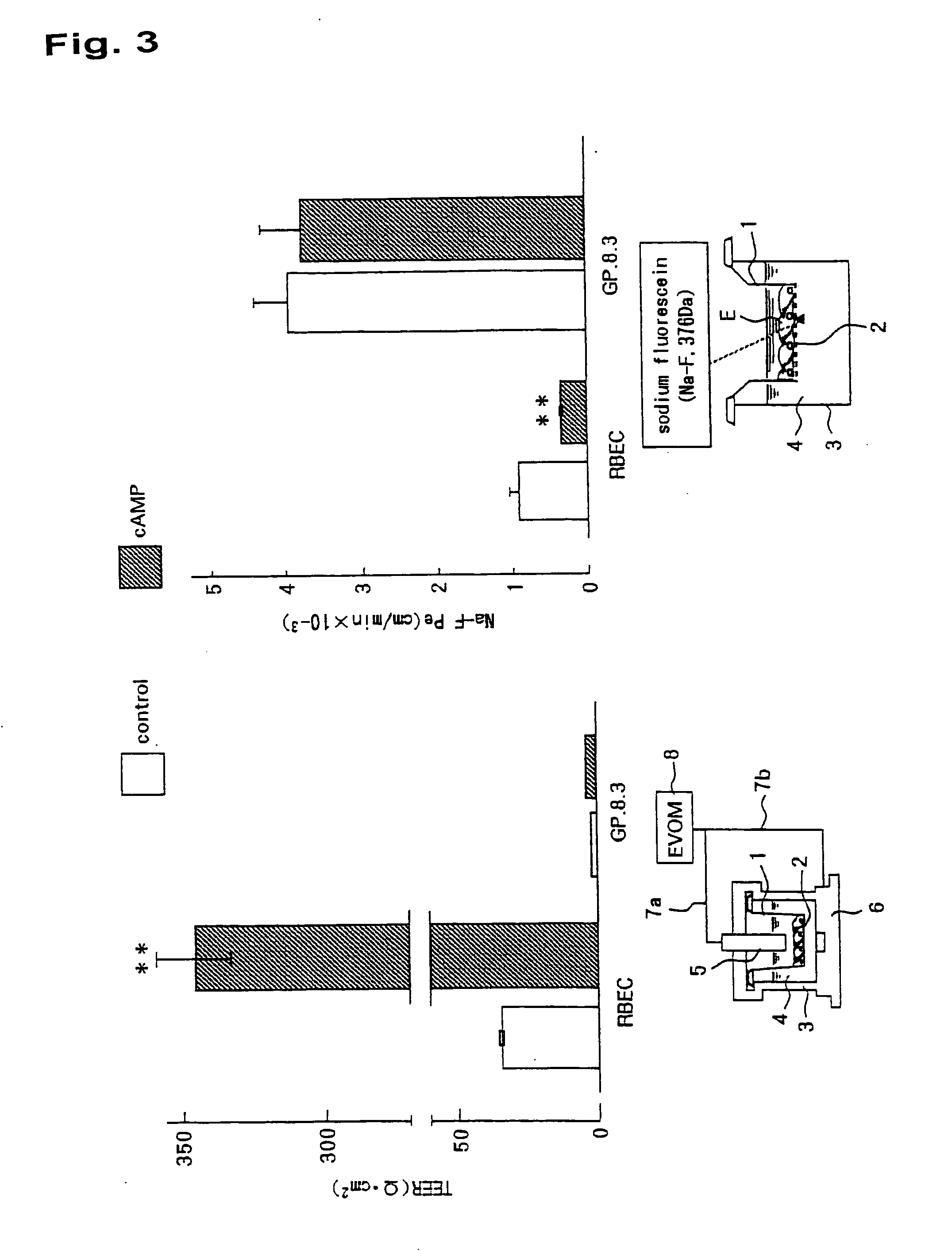In-Vitro Model of Blood-Brain Barrier, In-Vitro Model of Diseased Blood-Brain Barrier, and Drug Screening Method, Analysis Method for Functions of Diseased Blood-Brain Barrier, and Analysis Method for Pathogenesis Using the Same
a technology of bloodbrain barrier and in-vitro model, which is applied in the field of in-vitro model of bloodbrain barrier, can solve the problems of compound shortage as actual therapeutic drugs, the presence of bloodbrain barrier becomes a major obstacle to some artificial treatment of living organisms, and the development of drugs must be abandoned
- Summary
- Abstract
- Description
- Claims
- Application Information
AI Technical Summary
Benefits of technology
Problems solved by technology
Method used
Image
Examples
example 1
Isolation of Brain Capillary Slice
[0045]The brain of a three-week-old rat was excised within a clean bench and placed in an ice-cold Phosphate buffer saline (− / −) (PBS (− / −); Sigma). The dura mater, the cerebellum, the interbrain, the brain stem, and the like were removed on a sterilized filter paper to leave only the cerebral cortex. This cerebral cortex was placed in 3 ml of an ice-cold Dulbecco's Modified Eagle's Medium (DMEM; manufactured by Sigma) and finely cut into a size of approximately 1 mm3 with a surgical knife. 15 mL of DMEM containing enzymes (collagenase-class 2 (1 mg / ml; manufactured by Worthington) and 300 μL of DNase (15 μg / mL; manufactured by Sigma)) was further added thereto. The mixed solution was moved up and down 25 times with a 5-mL pipette to suspend a pellet. After shaking / incubation at 37° C. for 90 minutes, 10 mL of DMEM was added thereto, and the mixture was centrifuged. The precipitated pellet after centrifugation was centrifuged with 20% BSA (manufactu...
example 2
Brain Capillary Pericytes
[0046]The brain capillary slice of Example 1 contains a few percents of pericytes. Thus, the brain capillary slice was seeded onto a dish coated with collagen and cultured at 37° C. for 1 week in 5% CO2 / 95% atmosphere in a culture solution containing 10% fetal bovine serum (FBS)-DMEM supplemented with gentamicin (50 μg / mL) to promote pericyte growth. In this stage, the brain capillary endothelial cells are mixed with the pericytes. Next, the cells were detached with a 1×trypsin-EDTA solution (manufactured by Sigma) and seeded again onto a non-coated dish to isolate the pericytes (the endothelial cells cannot adhere to the dish, while only the pericytes grow therein).
example 3
Astrocytes
[0047]The brain was removed from a 1- or 2-day-old rat within a clean bench and placed in ice-cold PBS (− / −). The dura mater, the cerebellum, the interbrain, the brain stem, and the like were removed on a sterilized filter paper to leave only the cerebral cortex. This cerebral cortex was placed in a 50-mL tube, and 10 mL of ice-cold DMEM was added thereto. The mixed solution was slowly moved up and down with a 20-G syringe to break the tissue apart. The solution was left standing for a while. Then, 5 mL of the supernatant was placed in another 50-mL tube. 5 mL of DMEM was further added to 5 mL of the remaining cell suspension, and the mixed solution was moved up and down with a 20-G syringe. This procedure was repeated until the cell mass could not be observed visually. The last 5 mL of the cell suspension was also added thereto. Then, the cell suspension was passed through Cell Strainer (registered trademark; manufactured by Falcon) of 70 μm. The cells were collected by c...
PUM
 Login to View More
Login to View More Abstract
Description
Claims
Application Information
 Login to View More
Login to View More - R&D
- Intellectual Property
- Life Sciences
- Materials
- Tech Scout
- Unparalleled Data Quality
- Higher Quality Content
- 60% Fewer Hallucinations
Browse by: Latest US Patents, China's latest patents, Technical Efficacy Thesaurus, Application Domain, Technology Topic, Popular Technical Reports.
© 2025 PatSnap. All rights reserved.Legal|Privacy policy|Modern Slavery Act Transparency Statement|Sitemap|About US| Contact US: help@patsnap.com



